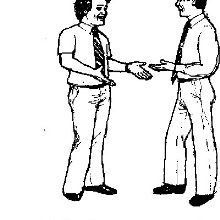Types and main phases of business communication

Business communication is an integral part of the life of modern society. Every day at work, people with a certain status and occupying a particular position resort to various types of it and strictly observe the public and private rules of business etiquette. Correctly structured business communication will lead even a novice manager to the successful achievement of the goal.

Peculiarities
Behind the concept of business communication is a kind of communication, the purpose of which is not the negotiation process itself, but the solution of a specific problem or the achievement of a specific goal, which is binding for all participants in the conversation and lies outside the communication process itself.
This type of communication differs from other types by the presence of the following circumstances:
- purpose, motives or activity should be common to all interlocutors;
- negotiators are in a common space-time interval: business communications can take place in any organization, group or team;
- all participants in this process are interconnected, social roles are clearly distributed between them and a communication hierarchy is built;
- communication in this context has strict regulations that must be obeyed by all participants, regardless of status: the norms of behavior in a work environment are business etiquette.

The basic rules of business etiquette include the following:
- Business interlocutors should adhere to a certain communication style, clearly and concisely formulate their thoughts, give weighty arguments in favor of their point of view and be able to listen and hear the interlocutor. This will help you to have a productive conversation without taking any extra time from business people.
- With such communication, the participants in the conversation should be as polite as possible... Business meetings are pursuing some kind of benefit, so sometimes you have to communicate with not very pleasant people.
- Understandable words and simple sentences are inherent in this style. Expressed in complex terms and foreign words, you can mislead a person or even offend him. In turn, this will interfere with the achievement of the set goal.


Functions
Business communication carries three main functions that have different ultimate goals and principles of human impact:
- Information and communication the function involves the collection and formation of specific information by the participants in the conversation, as well as the exchange of accumulated knowledge in the process of negotiations.
- Regulatory and communicative the function is aimed at correcting the behavior of participants in communication. During corporate communication, the subject regulates not only his own model of behavior, but also other participants in the conversation. To perform this function, the following methods are suitable: persuasion or suggestion within the framework of speech etiquette, copying behavior.
- Effectively communicative function is directly related to the emotional aspects of the subjects of communication.

Any kind of communication has a tremendous impact on the psycho-emotional state of a person, which affects his attitude to the world around him.
Views
All existing types of business communication are classified according to many parameters. Let's consider the most popular among the existing ones.
Depending on the method of information exchange, oral and written business communication are distinguished:
- Written types of business communication include all kinds of official documents. This can be a reference report, an explanatory note, reports and minutes of meetings, business letters, a statement, an internal charter of a company, a write-off act, an order, an indication in writing, a job description and much more. Any official document with signatures or seals is a subject of business communication.
- Negotiations, meetings, meetings, business conversations, reports, planning meetings can be attributed to the oral type of business communication.

By the way of interaction between the participants, there are direct and indirect types of business communication:
- Direct communication involves negotiations between partners without the use of additional funds, that is, the interlocutors are in the same room and communicate face to face.
- Indirect contact occurs with the use of modern means of communication - telephone, e-mail, video communication.
- Remote communication allows you to quickly resolve some issues between partners from different countries. But experience shows that face-to-face conversations are the most productive.

Another classification involves the division of types of business communications into verbal and non-verbal communication:
- Verbal communication involves interaction between people using human speech. With the help of language systems and depending on the intentions of a person, speech texts are formed. They can be both written and oral.
- Non-verbal interaction between people occurs without the use of speech. The means of this communication is the external manifestation of feelings and emotions - sign language, facial expressions, gaze and body motor skills. They are united by a common concept: kinestics.



Forms of interaction
In addition to types, there are also forms of business communication, they are divided into monological and dialogical.
- The first group includes forms of communication with one participant: report, appeal, welcome speech, advertising. In this case, a person acts as an orator and conveys some information to the listener. He must clearly understand what he is talking about, and be able to clearly express his thoughts.
- Dialogic forms presuppose the presence of two or more participants.

Negotiations are a suitable form of communication when discussing the most important issues and are:
- vertical - with higher authorities;
- horizontal - within the organization;
- unauthorized - that is, unplanned, carried out after school;
- at the highest level - only persons with the status of heads of interested companies meet;
- at the extended table - a meeting of working groups or specially appointed commissions.

Conversation, among other forms, has the most informal, simplified character. interactions in a work environment. This form includes any contact at work that is designed to solve a problem. Not everyone has the gift at the right time to have a casual conversation with their superiors and tactfully lead them to the solution of issues of interest.

Discussion or dispute is the way to solve the problem by comparing different, often opposite points of view. The result of a productive discussion is the adoption of a single decision by mutual agreement of the parties after listening in turn to all the positive and negative aspects. This form of communication has the most vivid emotional coloring, but in business circles it is customary to follow some rules. Opponents should not talk for a long time, interrupt each other.

The key to success is mutual respect and loyalty to the opinions of others.
Phases
It is customary to divide the process of a business conversation from its beginning to the achievement of a set goal into certain stages or phases.
Let's consider each of them in more detail.
- Preparing for an appointment. At this stage, it is very important to outline a plan for the upcoming conversation, to clearly define for yourself the range of tasks necessary for solving problems. In advance, it is worth making inquiries about the interlocutor, based on which to choose the tactics of the conversation and the necessary arguments. Indeed, the result of the meeting depends on how meaningful the meeting will be.
- Place and time mark for negotiations. The definition of this parameter depends on the role of the interlocutors. Usually the coordinates of the negotiations are set by the superior interlocutor. If the meeting is on an equal footing, then the participants can agree mutually.

- Setting up and making contact with the interlocutor. This phase, by its functional purpose, is the beginning of negotiations. Often, the first glance or the word of the interlocutor adds a subconscious attitude towards him and influences the desire to continue the conversation. During the establishment of contact, it is important to win over the interlocutor as soon as possible and complete the stage by establishing psychological contact - the moment when all participants in the communication are ready to get to the point.
- Problem identification and exchange of available information. In this phase, it is important to voice all the questions of interest, to indicate the direction of the conversation, to give a general understanding of the problem.
- Arguments in favor of the proposed solution... The argumentation phase is closely interconnected with the previous stage and flows smoothly from it. During this period, it is very important to note all the positive aspects of your vision of resolving the issue, to apply persuasion skills, especially if the interlocutor adheres to a different point of view.
- Counter-arguments. At this stage, there is a listening to the counter arguments of the interlocutor, who may not always agree. It is important to listen carefully and calmly to the interlocutor, to understand the essence of his position. Guiding questions will help you understand if the objection is related to a lack of information provided.
- Finding a compromise in solving the problem. In the process of alternately putting forward arguments and proposals, a search for a solution takes place that will suit all parties to the negotiations.
- Decision-making. This stage means the agreement of all parties with a single position, coming to a common denominator.

- Fixation of results. All business meetings end with the signing of a written confirmation of a joint decision.The agreement is a reflection of the fact that the meeting has a final result acceptable to all.
- End the contact. After discussing important issues, you need to be able to properly part with the interlocutors, perhaps leave a business card or ask for contact details from partners.
- Analysis the results obtained. This phase is final. It is designed to show how the decision made was correct and profitable for the participants in the conversation.

Based on this analysis, business partners make a decision on further cooperation or termination of contacts.
Tips & Tricks
The key to a successful business is a properly structured business communication with your clients and partners. To achieve this, some nuances must be taken into account.
- You must always keep the situation under control. The display of emotions and feelings is inappropriate in a business environment. Feelings of fear and insecurity can interfere with decision-making, and feelings of pity caused by the manipulation of the interlocutor can lead to the signing of an unprofitable contract. The manifestation of incontinence and aggression during dialogical types of communication, such as discussion, is unacceptable. With an unbalanced and always doubting partner, hardly anyone wants to deal with.
- Ability to anticipate the wishes of the client - another important component of successful business management, because in any business all the activities of the company are aimed at meeting the needs of the client. Attentiveness and courtesy, top-class service will make the client come back again.
- Planning and the ability to distinguish the main from the secondary. In any negotiation, it is important to speak briefly and clearly, without going deep into the details of the second plan. Business people usually have limited time, so you shouldn't prepare long monologues for important meetings.
- Business relationships should not interfere with personal ones. Even if a person is disliked, this does not mean that he cannot be useful in a business sense. The manifestation of a benevolent and supportive attitude, sincere interest in the arguments of the interlocutor will allow for a productive meeting.
- Honesty and transparency of intentions. During negotiations, you need to behave sincerely, confirming your words with facts and statistics. After all, any dishonest act for the sake of a profitable deal can permanently undermine the partner's trust and damage the reputation.
- Knowledge of the basics of business etiquette.

Simple rules such as offering a cup of coffee before the start of a meeting, a sincere desire to help with small things, and the ability to apologize in time for a mistake will set your partner or client in a positive mood and make you feel important.

The video below explains the 5 basic rules of business communication.








